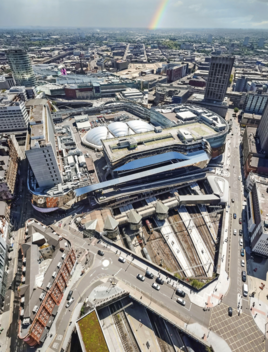Transport for the North covers a wider area than its West Midlands counterpart. Within its boundaries sat several PTEs, and today it covers several city regions. This prompts Hoggarth to a different view of funding by joining up investment from different bodies, public and private, in a virtuous circle.
“We all know it’s been difficult dealing with the rail industry, not only for local authorities but also for private sector investors,” he tells RailReview.
“That would include not just new stations, but investment in existing stations, which is an area where we could pilot more devolution because stations should be part of the community.”
And Hoggarth has a different view of future geography. Holmes has Birmingham as the centre of TfWM’s network, but Transport for the North has several city hubs, including Liverpool, Manchester and Leeds. They straddle the Pennines and sit in different Network Rail regions. Greater Manchester Mayor Andy Burnham has argued recently for a single region linking both sides of the Pennines.
Hoggarth says: “We’re very clear that GBR needs to work right across the North, so there’s a question about the regions that have been created. We’d definitely like to see a single regional route for the North. That’s been a long-standing view and it’s good to see a nod to it in the White Paper, albeit perhaps on a longer timescale than we would like because it talks about Northern Powerhouse Rail being the opportunity. That is definitely something we want to pursue.”
He adds: “This is the time when there is change within the industry, so this is an opportunity to grasp that and do something different. We know the arguments for and against because we’ve been through them before. You will end up creating a different set of interfaces, but our argument is that east-west is critical to what we do, not that we don’t value north-south and HS2 and London services. But the gap that’s existed has been east-west connectivity, and that’s why we came into existence - to make the case for that connectivity.”
NPR is TfN’s proposed new east-west line that’s designed to speed up journeys on that axis. It uses 80km (49.7 miles) of HS2’s planned tracks and so needs that project to go ahead. NPR is also a reason why TfN would keep Northern and TransPennine Express separate as operators.
Hoggarth explains: “When we did our original proposal together back in 2014, we did advocate putting Northern and TPE back together because we identified some efficiency savings in doing that. Having said that, the view at the time was that it was better to keep them apart because of the ambition we shared of making TPE the inter-city operator of the North. Looking at the new trains and the ways it has developed the routes, you can see how that has really helped.
“I think there’s a further stage in developing that inter-city operator towards Northern Powerhouse Rail, so we will need to see how that pans out on the back of the Integrated Rail Plan.”
Couple this with TfN’s wider 30-year strategy and it’s easy to see why Hoggarth argues that TfN is an ideal partner for GBR. It’s done much of the hard work already, it’s collected evidence, and it’s given an informed view that’s been past local politicians.
What is also clear is that putting aside their desire for devolution in general terms, TfN and TfWM share some approaches but differ in others. What fits one will not necessarily fit another. That’s the biggest devolution lesson. And history suggests that how you define relationships and place boundaries is difficult in a national rail network.ν












